Trees Birds Mammals Fish Amphibians Reptiles
Wild Algarve
Bookshop
Inocybe pusio P. Karst. - Laddie's Fibrecap
Phylum: Basidiomycota - Class: Agaricomycetes - Order: Agaricales - Family: Inocybaceae
Distribution - Taxonomic History - Etymology - Identification - Culinary Notes - Reference Sources
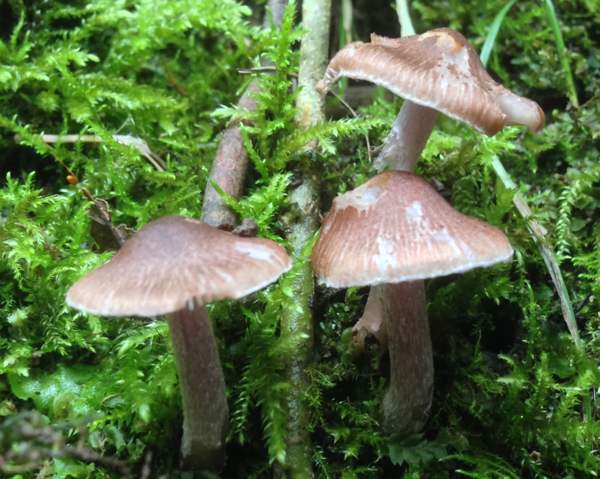
Inocybe pusio occurs under broad-leaf trees,
in summer and autumn. This fungus almost certainly contains the dangerous poison
muscarine, and so it must be avoided at all costs when gathering fungi to eat.
Inocybe is a difficult genus, with numerous 'little brown mushrooms' (LBMs as they are commonly called) that to the naked eye appear to be identical until they are examined under a microscope... and even then it is very difficult to separate many of them.
Alan Outen and Penny Cullington have produced a very detailed key, without which I would not want even to attempt identification of fibrecap mushrooms. It takes time: this is not a simple process, but it is very straightforward to follow. You need specimens in prime condition complete with any basal bulb, and it is crucial to minimise handling, otherwise this may remove caulocystidia (stem cystidia) or other identifying features. See the references section below.
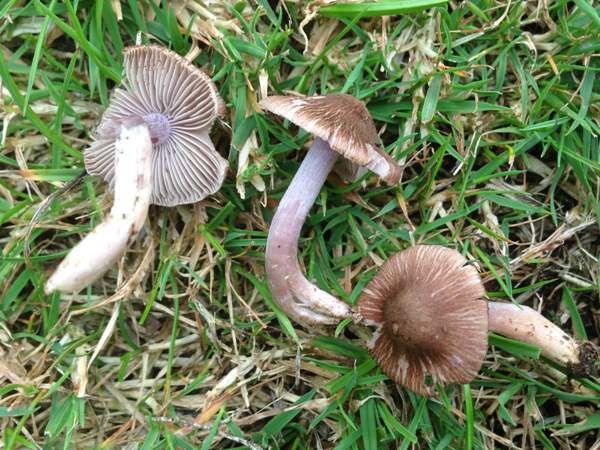
Distribution
Inocybe pusio is an uncommon but widespread woodland species in Britain. (I can find no records of this species in Ireland.) These toxic toadstools are found in most parts of mainland Europe, and they are also recorded in North America and in Australia.
Taxonomic History
In 1889 Finish mycologist Petter Adolf Karsten described this mushroom scientifically, giving it the name Inocybe pusio, by which it is generally known today.
Synonyms of Inocybe pusio include Inocybe obscura var. obscurissima R. Heim,
Etymology
Inocybe, the genus name, means 'fibrous head', while the specific epithet pusio is a Latin noun meaning 'little boy'. It's a long time since I was a little boy, but I don't think I looked much like this little toadstool; however, maybe in Petter Karsten's time boys in northern Scandinavia were small and brown with pointed heads.
Identification guide
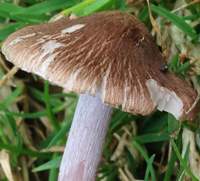 |
Cap
The brown cap of Inocybe pusio has a diameter of 1 to 3.5cm. sharply
conical at first, it gradually flattens often retaining a smooth or very finely tomentose central umbo. The outer region is rimulose (breaking into streaky brown radial fibres, progressively paler towards the margin and tending to split its flesh radially towards the edge of the cap). Beneath the cuticle the flesh is white, unchanging on exposure to air. |
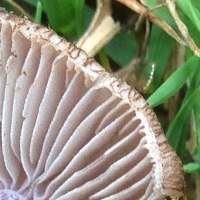 |
Gills
The moderately crowded, adnexed or adnate gills start off creamy-grey
with a violaceous tinge, and they turn browner as the spores mature. |
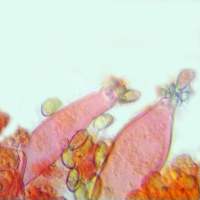 |
Cheilocystidia
Gill-edge cystidia are cylindrical to fusiform or langeniform, thin-walled, 40-75 x 10-15µm. encrusted with apical cystals.
|
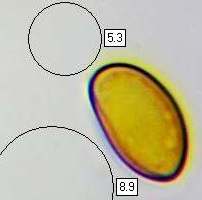 |
Spores
Ellipsoidal to subamygdaliform with a pointed apex, smooth 8-11 x 4.5-6µm.
Spore print
Dull brown. |
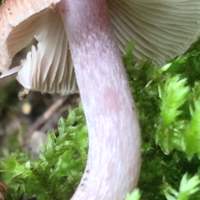 |
Stem
3 to 6mm in diameter and 2 to 5cm tall, the stem is pruinose and silky,
violaceous to grey-violaceous towards the apex; it is smoother and whitish below. The base is slightly swollen, and there is no stem ring. |
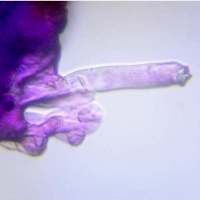 |
Caulocystidia
Stem surface cystidia are present in the upper third of the stem, and in form and dimensions they are similar to the cheilocystidia.
Show larger image
|
Odour/taste |
Slightly spermatic smell. Reported to
have a mild taste (but please be aware that this is almost certainly a poisonous
fungus). |
Habitat & Ecological role |
Mycorrhizal with
deciduous trees often on rich soil, in woodland and parkland. |
Season |
Late June to November in Britain and Ireland. |
Similar species |
Inocybe erubescens (synonym Inocybe patouillardii) is initially pale cream and gradually becomes brick red.
Several other fibrecaps are macroscopically similar to Inocybe pusio, and use of specialist keys, microscopic examination and sometimes chemical tests are necessary to achieve confident identification to species level. |
Culinary Notes
Several Inocybe species are known to be deadly poisonous and difficult to identify with confidence, and so they should all be avoided when gathering fungi for food.
Reference Sources
Fascinated by Fungi, 2nd Edition, Pat O'Reilly 2016, reprinted by Coch-y-bonddu Books in 2022.
BMS List of English Names for Fungi
Alan Outen and Penny Cullington (2009), Keys to the British Species of Inocybe.
Dictionary of the Fungi; Paul M. Kirk, Paul F. Cannon, David W. Minter and J. A. Stalpers; CABI, 2008
Taxonomic history and synonym information on these pages is drawn from many sources but in particular from the British Mycological Society's GB Checklist of Fungi.
Acknowledgements
This page includes pictures kindly contributed by Simon Harding.
Top of page...
Fascinated by Fungi. Back by popular demand, Pat O'Reilly's best-selling 450-page hardback book is available now. The latest second edition was republished with a sparkling new cover design in September 2022 by Coch-y-Bonddu Books. Full details and copies are available from the publisher's online bookshop...